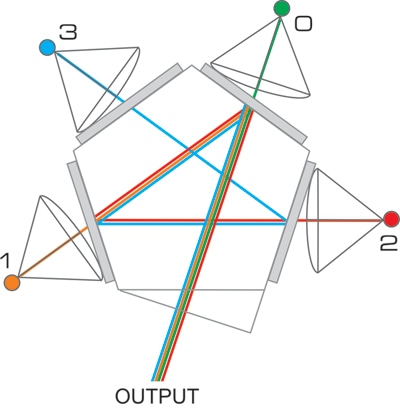The Lambda 421 beam combiner is a new, patented, concept for combining separate light sources with different spectra into a single common output beam. Each separate light source is collimated before entering the optical path through a bandpass filter.
The filters for each light source also function as mirrors that reflect the collimated beams from the previous light sources. In the diagram below the optical paths are outlined for each position including the reflections that occur:

Optical path for each light source position from 0 through 3. Image credit: Sutter Instrument
Traditionally, combining more than two light sources required the use of a dichroic ladder. Dichroic mirrors, which switch from transmission to reflection at one point in the spectrum, allow the combining of separate light sources, provided that those sources do not have overlapping wavelengths. The downside of this approach is that light sources cannot be easily changed.
Dichroic ladders also demand careful attention to the order in which the light sources are introduced into the optical path to avoid having the light blocked by the next dichroic in line.
Typically, additional bandpass filters must be added in front of each light source before the dichroic, to select the desired range of wavelengths for each source. Each filter and dichroic used in the ladder decreases the total light output of the system.
Features
- Capable of combining any light source
- Any suitable filter can be placed in any of 4 positions without concern for the order
- Wavelength selection and beam reflection using Semrock STR Filters
The Lambda 421 was designed to keep the size of the beam combiner small and the optical path short and efficient. Thin-film bandpass filters, such as Semrock’s STR, reflect greater than 90% of out-of-band light.
If the band pass of each light source does not overlap, it is possible to use the filters for both attenuation and reflection of the light from the other sources. By arranging the filters and sources into a pentagon, we were able to combine four LED wavelengths in a compact design with lower losses than previously achievable.
As an added benefit, the last position in the optical train does not require any filter, since no other input reflects from that position. This input can be used with any sort of light source as long as you are aware of the possible losses if there are filters in use that overlap this light source.
The fifth side of the pentagon becomes the output for the combined sources. The filters are easily exchangeable and are installed on small sliders inside the core of the pentagon. Filters and associated light sources can be arranged in any order around the pentagon.
In the diagram below the position number of the light sources are labeled based on the number of total reflections.

Image credit: Sutter Instrument
Notes
- The light from position #0 goes directly to the device output without being reflected. This position might be preferred for the source with the greatest desired output.
- The filter for the fourth light source is not used as a reflective surface and could be omitted if a broad-band source were desired.
- In configurations with fewer than 4 light sources, sources should be filled from lowest to highest number of reflections to ensure the greatest light output.
- The optical path for each input is tilted by 18 degrees relative to the filter for that port. This will cause a small shift in the band pass toward shorter wavelengths. While it would be ideal to have a coating optimized for this application, we have found that stock -STR filters can be used if you correct for the shift in the band pass when selecting the filters. This lends itself to combining narrow-band sources such as LEDs and lasers with a broad-band sources such as an arc lamps or white light LEDs. In the case of LEDs, wavelengths can be shuttered at the speed of the individual source. Sutter Instrument HPX and TLED products can switch in 10-25 microseconds respectively, making the Lambda 421 one of, if not the fastest wavelength switcher on the market. The Lambda Pentagon beam combiner is designed for flexibility and expandability. Should your illumination need change over time a simple configuration change and possibly additional filters can produce an entirely different output.